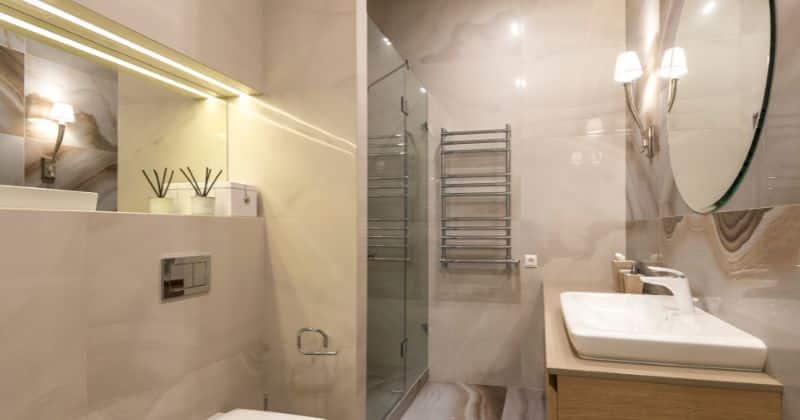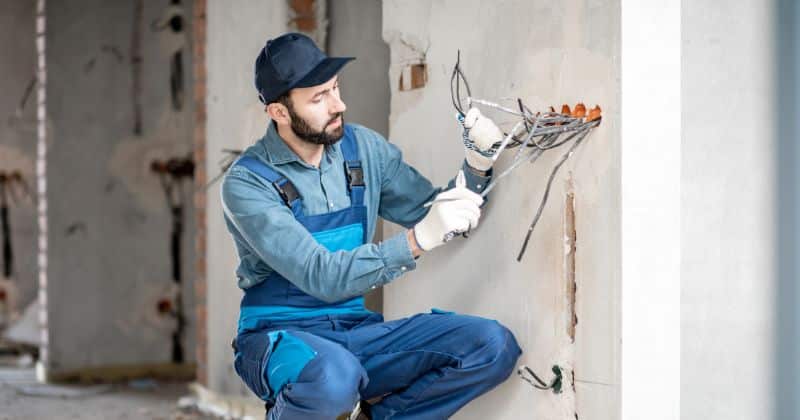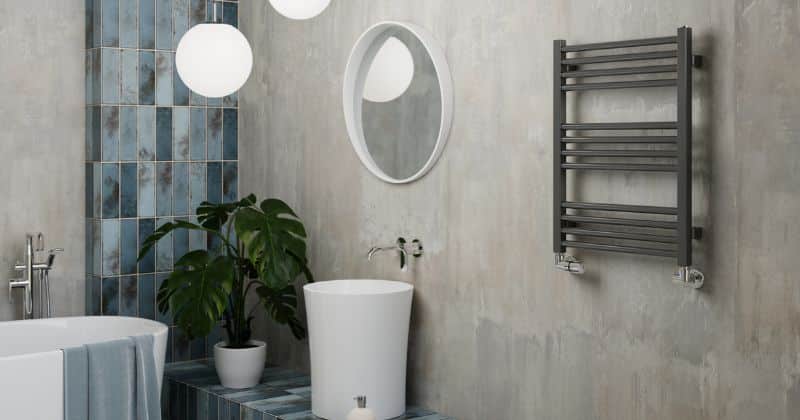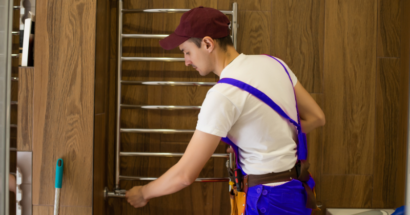Imagine it’s a cold, damp morning in your cosy home. You’ve just stepped out of a refreshing shower and are reaching for your towel. But instead of the usual chilly, slightly damp cloth, you’re greeted by a warm, dry embrace from your heated towel rail.
Heated towel rails are a perfect mix of luxury and practicality. They keep your towels dry and warm, ready for those chilly days. Understanding the heated towel rail installation process and regulations is key. It ensures everything is safe and works perfectly.
Are you a homeowner seeking bathroom comfort? A renter looking for efficient heating? Or an energy-conscious individual aiming to cut down on bills?
Then, a heated towel rail installation might be your next home project!
In this guide, we’ll cover how to fit a heated towel rail, provide best practices for pre and post heated towel rail installation, explore who can install a heated towel rail, and highlight the benefit it brings to the users.
So, keep reading to learn how to add this touch of luxury and comfort to your everyday routine at your home.
What Is the Purpose of a Heated Towel Rail?
A heated towel rail is like your towel’s cosy home in the bathroom. It’s not just a rack; it’s there to make your life warmer and better. Picture this: you step out of the shower on a chilly morning, and instead of grabbing a cold, damp towel, you wrap yourself in one that’s warm and snug.
That’s the amazing comfort of a heated towel rail – it keeps your towels dry and toasty, ready to give you a little comfort hug after every bath.
This simple addition elevates your daily routine, making drying off a moment of comfort and luxury. Practicality aside, it adds a touch of joy and comfort to your home.
Upgrade Your Bathroom Experience: 8 Worthy Reasons to Choose Heated Towel Rail Installation
Heated towel rails have become a must-have in modern homes, and it’s easy to see why. Here are eight top-notch benefits of installing this modern and innovative appliance:
- Luxurious Comfort: Imagine always stepping into a cosy, warm towel after your bath. It feels like a hug!
- Efficient Drying: No more damp towels! These rails dry your towels fast.
- Hygienic Solution: Warm, dry towels mean less dampness, so your towels stay fresh and nice.
- Energy Efficiency: These rails use less electricity, which is good for the planet and your electricity bills.
- Space-Saving Innovation: They’re like two-in-one: a towel dryer and a room heater, perfect for small bathrooms. Alternatively, consider bathroom electric radiators for efficient heating in compact spaces.
- Aesthetic Appeal: They come in cool designs that make your bathroom look great.
- Increased Home Value: With these stylish rails in your bathroom, your house could be worth more.
- Simple Installation: With simple steps, you can set them up yourself or get someone to help.
All You Need to Know About Heated Towel Rail Installation Regulations
Installing a heated towel rail can transform your bathroom experience. However, following UK regulations is important to ensure safety and efficiency. These regulations might seem complex, but we’ve broken them into simple, easy-to-understand points.
Part P of the Building Regulations: Safety First in Bathroom Electrics
Before you start, know that Part P of the Building Regulations is about keeping you safe. It covers electrical installations in bathrooms, including heated towel rails. Here’s a simplified list of what Part P involves:
- Safe Installation Areas: It specifies safe zones in the bathroom for electrical installations, reducing the risk of accidents.
- Protection Against Water: Given the high moisture in bathrooms, Part P ensures all electrical fittings are protected against water damage.
- Shock Prevention Measures: It mandates safety devices like circuit breakers to prevent electric shocks, keeping you and your family safe.
Electrical Equipment (Safety) Regulations: Ensuring Your Towel Rail is Safe
When choosing a heated towel rail, these regulations make sure it’s safe for use in your home:
- Design and Construction: The towel rail must be designed and built to avoid any electrical hazards, ensuring it’s safe to use in a wet bathroom environment.
- Quality Materials: It should be made from durable materials that won’t wear out quickly or malfunction.
- Mandatory Safety Testing: Before being sold, the towel rail must undergo rigorous safety testing to meet UK safety standards.
Electromagnetic Compatibility Regulations: Avoiding Electronic Interference
These regulations ensure your heated towel rail doesn’t interfere with other electronic devices in your home:
- Limiting Electromagnetic Emissions: The towel rail should not emit electromagnetic waves that could disrupt other devices like radios or TVs.
- Resistance to External Disturbances: It should be able to operate normally even when there are electromagnetic disturbances from other sources.
For more detailed information, you can check out the guidelines on Compliance Gate.
Remember, these rules ensure your heated towel rail is a safe and cosy addition to your bathroom. If unsure, asking a professional electrician is always a good idea.
Are Heated Towel Rails Safe?
Heated towel rails are safe but must be installed and used correctly, like any bathroom electrical appliance. The main safety concern is their proximity to water, as bathrooms are naturally wet environments. However, modern heated towel rails are designed to be safe for use in such conditions, provided they are installed correctly.
Planning Your Heated Towel Rail Installation
When it comes to adding a heated towel rail to your bathroom, planning is key. It’s not just about picking any towel rail and attaching it to the wall.
It would help if you considered several factors to ensure it’s the right fit for your space, both in size and style, and functions efficiently and safely. Let’s delve into the key factors you need to consider for a successful heated towel rail installation.
Size and Power Considerations for Heated Towel Rail Installation
Before choosing a heated towel rail, consider the size and power needed for your bathroom. Here’s a simple guide to help you:
- Measure Your Space: The size of your bathroom will determine the size of the towel rail you need. A small rail for a large bathroom won’t be effective, and a large rail for a small bathroom could be overpowering.
- Consider the Heat Output: The power of the towel rail, often measured in BTUs (British Thermal Units), should be enough to warm your towels and the room. A higher BTU means more heat output.
- Balance with Bathroom Decor: The style and finish of the towel rail should complement your bathroom’s decor. Whether it’s a modern chrome or a classic white, choose one that fits your style.
Where to Install Your Heated Towel Rail
Selecting the right location for your heated towel rail is more than just a matter of convenience; it’s about maximising efficiency and ensuring safety. Here are some tips to help you choose the best spot:
- Safety First: Safety is a top priority. Install the towel rail safely from water sources to avoid any electrical hazards. A minimum height of 600 mm above the ground is recommended.
- Maximise Efficiency: For the best heating efficiency, place your towel rail where it can distribute heat evenly throughout the bathroom. Avoid tucking it away in corners or behind doors. Alternatively, a cloakroom electric radiator can offer targeted warmth for compact areas while saving wall space.
- Ease of Access: Convenience is key. Install your towel rail within easy reach of your shower or bath, so a warm towel is always available.
Heated Towel Rails and Safety
Safety should always be a top priority when installing and using a heated towel rail. Here are some important considerations:
- Temperature Control: Modern heated towel rails come equipped with temperature control features, ensuring they remain safe to touch and don’t overheat.
- Safety Standards: Always opt for towel rails that adhere to UK safety standards. This guarantees they have undergone rigorous testing for safe operation in bathroom conditions.
- Professional Installation: Professional installation is advised while you might be tempted to install it yourself. This ensures safety and compliance with heated towel rail installation regulations.
Pre-Installation Checklist For Heated Towel Rail Installation
Getting ready to install a heated towel rail? It’s important to be well-prepared. This means knowing what you need to do and having the right tools. A good start makes the whole process smoother and safer.
Let’s look at what you should do before you start, the tools you’ll need, and some key safety tips.
Key Steps Before Installation
Before diving into the installation process, let’s focus on a few crucial steps that set the foundation for a successful heated towel rail setup.
- Check Your Heated Towel Rail: Remove it from the box and look it over for damage when your heated towel rail arrives.
- Turn Off the Water: Turn off your water supply before you begin any work in the bathroom.
- Marking the Spot: Decide where your towel rail will go. Mark the wall for where the rail will hang and where the screws need to go.
- Ready to Drill: Drill holes where you’ve made your marks. Be sure they’re straight and the right distance apart.
Tools Required for the Job
Gather the tools needed for a successful installation:
- Wrench that you can adjust
- Pencil for marking spots
- Screwdriver with a cross-head
- Drill with the right bits
- Level to keep things straight
- Measuring tape
- Fixings for the wall (these should come with your towel rail)
- Screws and plugs for the wall (you might need to get these separately)
- Valves for your towel rail
Safety Measures to Follow
Before you start, consider safety with these precautions:
- Appropriate Attire: Depending on the task, consider using gloves, safety glasses, or other protective gear.
- Tool Handling Caution: Exercise care when using power tools, particularly drills.
- Check for Hidden Hazards: Before drilling, ensure no pipes or wires are in the way to avoid accidental damage.
- Moderate Tightening: Avoid overtightening to prevent breakage when assembling components like the air vent or plug.
Instructions to Install the Heated Towel Rail
Installing a heated towel rail in your bathroom adds a touch of luxury and provides the practical benefit of warm, dry towels. The process, while straightforward, requires attention to detail and adherence to safety standards.
Here’s a step-by-step guide to ensure a successful installation.
Mounting the Brackets
Before you start, ensure you have the right tools and that the power and water supply (if necessary) are turned off. The first step is to mount the brackets:
- Measuring and Marking: Measure the wall according to the manufacturer’s specifications to ensure accurate placement of the brackets.
- Drilling and Securing: Drill holes at the marked spots and securely attach the brackets using the provided screws.
Attaching The Towel Rail
Once the brackets are in place, it’s time to attach the towel rail:
- Aligning the Rail: Carefully align the heated towel rail with the installed brackets, ensuring it is level.
- Securing the Rail: Fasten the towel rail to the brackets with the provided screws or mounting hardware. Check for any wobbling or instability.
Wiring and Plumbing Connections
The final step involves making the necessary connections:
- Electrical Connection: If your towel rail is electric, follow the manufacturer’s instructions to wire it to a power source. Always prioritise safety when dealing with electrical components.
- Plumbing Connection: A professional plumber is recommended to ensure a safe connection to your water supply for hydronic towel rails.
Testing the heated towel rail after installation ensures it functions correctly. If you encounter any issues, refer to the troubleshooting guide or seek professional help.
Post-Installation Tips Fitting a Heated Towel Rail
After successfully installing a heated towel rail in your bathroom, there are a few final steps and maintenance tips to ensure optimal performance and longevity.
- Testing the Heated Towel Rail: Testing the towel rail is crucial once installed. Turn on the power and check if it heats up as expected. If you encounter any issues, refer to the manufacturer’s troubleshooting guide or seek professional help.
- Maintaining and Cleaning Your Towel Rail: Regular cleaning is essential to keep your heated towel rail in top condition. Use a soft cloth and mild detergent for cleaning. Avoid using abrasive materials that could damage the surface.
Fitting a Heated Towel Rail: DIY or Professional Help?
When considering the installation of a heated towel rail, it’s important to understand when you can do it yourself and when you might need a professional, like an electrician.
Do You Need an Electrician?
- DIY Installation: If your towel rail plugs into a wall socket, install it yourself. These models are user-friendly and come with clear instructions.
- Professional Installation: For towel rails that need to be wired into your home’s electrical system, hire an electrician. This ensures safety and meets legal standards.
When to Call a Professional
- Hardwiring Needed: An electrician is necessary for safe installation if your towel rail doesn’t have a plug.
- Complex Setups: If the installation involves more than just plugging in, like special mounting, get professional help.
DIY: Simple and Safe
- Plug-In Models: Easy to install independently. Just follow the instructions.
- Basic Tools: You’ll need simple tools like a drill, level, and tape measure.
Do Heated Towel Rails Use Much Electricity?
When it comes to incorporating heated towel rails in your bathroom, a common question arises: Do they consume a lot of electricity? Understanding their energy consumption is critical to evaluating their impact on electricity bills.
Electricity Consumption
Heated towel rails typically have a power usage similar to small household appliances. Their energy consumption generally ranges between 100 to 300 watts, comparable to the electricity used by a standard light bulb.
Impact on Electricity Bills
The good news is that the effect of heated towel rails on your electricity bills is usually modest. Opting for models with timers or thermostats is advisable to manage energy costs further. These features enable you to control the heating times, thus minimising unnecessary energy use.
Efficiency and Safety
Ensuring your heated towel rail’s efficient and safe operation is essential. Adhering to the manufacturer’s installation guidelines and conducting regular maintenance checks can prevent overconsumption of electricity and ensure safe usage, thereby avoiding any safety risks.
Future of Home Comfort: Heated Towel Rail Installation Regulations
Heated towel rails are becoming popular for modern homes, blending convenience with style. If you’re thinking about fitting a heated towel rail or curious how to use it, remember they are both practical and stylish additions to your home.
For assistance or advice, particularly in selecting the right electric radiators, please visit our website at Best Electric Radiators.
Our team is prepared to guide you whether you’re undertaking a new installation or addressing an issue with a heated towel rail not working. We aim to help you find the ideal solution for your home, combining efficiency with sophistication
FAQs
What Height Should a Heated Towel Rail Be Installed?
Heated towel rails should typically be installed about 120 cm from the floor. This height ensures optimal performance and safety, keeping the rail clear of water splashes.
Can Heated Towel Rails Be Floor-mounted?
Yes, heated towel rails can be floor-mounted. While most are wall-mounted for safety and space efficiency, floor-mounted models are available. However, it’s crucial to ensure they are installed away from water sources to prevent electrical hazards.
Can a Heated Towel Rail Overheat?
No, quality heated towel rails are designed not to overheat. They come with built-in thermostats to prevent overheating. However, following the manufacturer’s guidelines and using rails that meet safety standards is important.
Can You Leave the Heated Towel Rail Overnight?
Yes, it’s generally safe to leave a heated towel rail on overnight, especially if it has a thermostat. However, it’s advisable to use a rail with a timer to control its operation for energy efficiency.
Do Heated Towel Rails Need Water?
It depends on the type. Traditional heated towel rails connected to the central heating system need water to heat up. However, electric towel rails do not require water as they use electric elements for heating.
Do Heated Towel Rails Need Valves?
Yes, if they are connected to the central heating system. Heated towel rails in this setup require valves to control the flow of hot water. Electric towel rails, on the other hand, do not need valves.
What Makes a Good Heated Towel Rail?
A good heated towel rail should be efficient, safe, and match your bathroom’s aesthetics. Look for rails with adjustable heat settings, safety features, and a design that complements your space. For a wide selection of high-quality options, visit Best Electric Radiators.












Leave a Reply